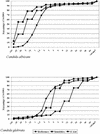Multicenter comparative evaluation of six commercial systems and the national committee for clinical laboratory standards m27-a broth microdilution method for fluconazole susceptibility testing of Candida species
- PMID: 12149358
- PMCID: PMC120637
- DOI: 10.1128/JCM.40.8.2953-2958.2002
Multicenter comparative evaluation of six commercial systems and the national committee for clinical laboratory standards m27-a broth microdilution method for fluconazole susceptibility testing of Candida species
Abstract
Fluconazole susceptibility among 800 clinical Candida isolates (60% C. albicans) and two control strains (C. krusei ATCC 6258 and C. parapsilosis ATCC 22019) was tested with the NCCLS M27-A method (gold standard) and six commercial products (Candifast, disk, Etest, Fungitest, Integral System Yeasts, and Sensititre YeastOne). Results were classified as susceptible, susceptible-dose dependent, or resistant using M27-A breakpoints or, for Fungitest, Integral System Yeasts, and Candifast, as susceptible, intermediate, or resistant, according to the manufacturers' instructions. Concordance with NCCLS M27-A results was analyzed with the chi(2) test. Intra- and interlaboratory reproducibility was also evaluated. NCCLS M27-A (90.1%), Etest (93.1%), Sensititre YeastOne (93.1%), disk (96.7%), Fungitest (92.6%), Integral System Yeasts (40.6%), and Candifast (6.0%) classified the indicated percentages of C. albicans isolates as susceptible. Among non-C. albicans strains, the percentages of susceptible isolates were as follows: NCCLS M27-A, 74.0%; Etest, 83.8%; Sensititre YeastOne, 64.1%; disk, 60.6%; Fungitest, 76.6%; Integral System Yeasts, 28.3%; and Candifast, 27.4%. All methods except Candifast and Integral System Yeasts showed good agreement with NCCLS M27-A results for both C albicans and non-C. albicans isolates. Intralaboratory reproducibility was excellent for NCCLS M27-A, Etest, Sensititre YeastOne, disk, and Fungitest (88 to 91%). Similar results emerged from the interlaboratory reproducibility evaluation. Our findings indicate that some commercial methods can be useful for fluconazole susceptibility testing of clinical Candida isolates. Those characterized by a lack of medium standardization and/or objective interpretative criteria should be avoided. Particular caution is necessary when testing is being done for clinical and epidemiological purposes.
Figures
References
-
- Arthington-Skaggs, B. A., M. Motley, D. W. Warnock, and C. J. Morrison. 2000. Comparative evaluation of PASCO and National Committee for Clinical Laboratory Standards M27-A broth microdilution methods for antifungal drug susceptibility testing of yeasts. J. Clin. Microbiol. 38:2254-2260. - PMC - PubMed
-
- Cormican, M. G., and M. A. Pfaller. 1996. Standardization of antifungal susceptibility testing. J. Antimicrob. Chemother. 38:561-578. - PubMed
-
- Davey, K. G., A. Szekely, E. M. Johnson, and D. W. Warnock. 1998. Comparison of a new commercial colorimetric microdilution method with a standard method for in-vitro susceptibility testing of Candida spp. and Cryptococcus neoformans. J. Antimicrob. Chemother. 42:439-444. - PubMed
Publication types
MeSH terms
Substances
LinkOut - more resources
Full Text Sources


